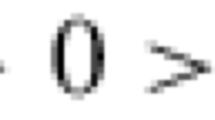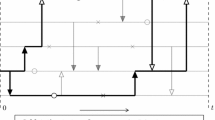Abstract
Let birth rates and death rates be constant, birth rates positive, fertilities additive, and each birth rate not larger than twice any other birth rate. Global convergence to equilibria is proved for the model in the title. There is at most one polymorphic equilibrium or there are a continuum of equilibria. The phase portraits are given. If there is a polymorphic equilibrium, then the largest negatively invariant set in the state space is a continuous curve connecting the two fixation equilibria. This curve coincides with the Hardy-Weinberg manifold exactly when the death rate is additive. Disregarding extinction, the polymorphic equilibria are the same for the continuous model as for the corresponding discrete model exactly when the death rate is additive.
Similar content being viewed by others
References
Abugov, R.: Genetics of Darwinian fitness. II. Pleiotropic selection on fertility and survival. J. Theor. Biol. 114, 109–125 (1985)
Akin, E.: The geometry of population genetics. (Lect. Notes Biomath., vol. 31) Berlin Heidelberg New York: Springer 1979
Akin, E., Hofbauer, J.: Recurrence of the unfit. Math. Biosci. 61, 51–63 (1982)
Arnold, V. I.: Geometrical methods in the theory of ordinary differential equations. (Grunl. Math. Wiss., vol. 250) Berlin Heidelberg New York: Springer 1983
Fisher, R. A.: The genetical theory of natural selection. Oxford: Oxford University Press 1930
Hadeler, K. P.: Stable polymorphisms in a selection model with mutation. SIAM J. Appl. Math. 41, 1–7 (1981)
Hadeler, K. P., Glas, D.: Quasimonotone systems and convergence to equilibrium in a population genetic model. J. Math. Anal. Appl. 95, 297–303 (1983)
Hirsch, M. W.: Systems of differential equations which are competitive or cooperative. I: Limit sets. SIAM J. Math. Anal. 13, 167–179 (1982)
Hofbauer, J.: The selection mutation equation. J. Math. Biol. 23, 41–53 (1985)
Hofbauer, J., Sigmund, K.: The Theory of Evolution and Dynamical Systems. (Lond. Math. Soc. Stud. Texts, vol. 7) Cambridge: Cambridge University Press 1988
Karlin, S., Lessard, S.: Theoretical studies on sex ratio evolution. Princeton, NJ: Princeton University Press 1986
Kingman, J. F. C.: A matrix inequality. Q. J. Math. 12, 78–80 (1961)
Koch, M., Kemler, F.: A one locus-two allele model admitting stable limit cycles. J. Theor. Biol. 122, 263–267 (1986)
Lessard, S.: Évolution du rapport numérique des sexes et modèles dynamiques connexes. In: Lessard, S. (ed.) Mathematical and Statistical Developments of Evolutionary Theory, pp. 269–325. Norwell, MA: Kluwer 1990
Losert, V., Akin, E.: Dynamics of games and genes: discrete versus continuous time. J. Math. Biol. 17, 241–251 (1983)
Lyubich, Yu. I., Maistrovskii, G. D., Ol'khovskii, Yu. G.: Selection-induced convergence to equilibrium in a single-locus autosomal population. Probl. Inf. Transm. 16, 66–75 (1980)
Nagylaki, T., Crow, J. F.: Continuous Selective Models. Theor. Popul. Biol. 5, 257–283 (1974)
Nagylaki, T.: Selection in one- and two-locus systems. Berlin Heidelberg New York: Springer 1977
Nagylaki, T.: Evolution under Fertility and Viability Selection. Genetics 115, 367–375 (1987)
Palm, G.: On the selection model for a sex-linked locus. J. Math. Biol. 1, 47–50 (1974)
Selgrade, J. F., Ziehe, M.: Convergence to equilibrium in a genetic model with differential viability between the sexes. J. Math. Biol. 25, 477–490 (1987)
Szucs, J. M.: Selection and mutation at a diallelic X-linked locus. J. Math. Biol. 29, 587–627 (1991a)
Szucs, J. M.: Selection at a diallelic autosomal locus in a dioecious population. J. Math. Biol. 29, 693–713 (1991b)
Szucs, J. M.: Selection-mutation at a diallelic autosomal locus in a dioccious population. J. Math. Biol. 30, 1–14 (1991c)
Wiggins, S.: Introduction to applied nonlinear dynamical systems and chaos (Texts Appl. Math., vol. 2) Berlin Heidelberg New York: Springer 1990
Author information
Authors and Affiliations
Rights and permissions
About this article
Cite this article
Szucs, J.M. Equilibria and dynamics of selection at a diallelic autosomal locus in the Nagylaki-Crow continuous model of a monoecious population. J. Math. Biol. 31, 317–349 (1993). https://doi.org/10.1007/BF00163920
Received:
Revised:
Issue Date:
DOI: https://doi.org/10.1007/BF00163920




